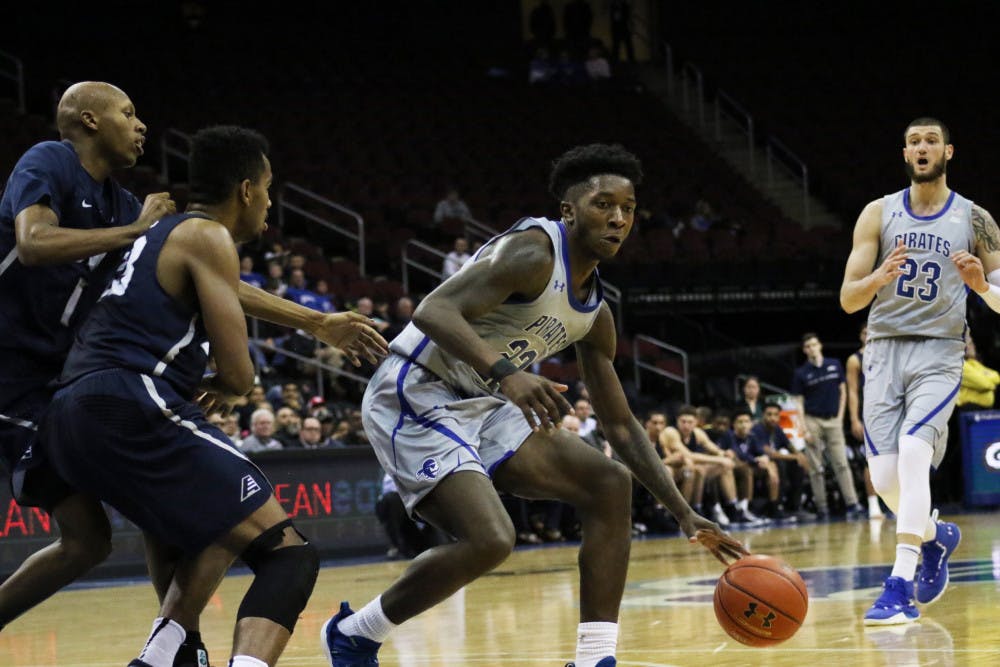Myles Cale was relegated to riding the pine to start the game on Feb. 5 against Georgetown. For the 6-foot-6 junior, it was the first time that he was not on the floor for the opening tip for Seton Hall since his freshman year – the Round of 32 loss to Kansas that ended the Pirates’ hopeful March run.
Prior to that game, Cale had started the last five to end that season, including in a win over North Carolina State to propel the Pirates to the next round of the Big Dance.

It undoubtedly had to be a strange feeling for Cale. Heading into the season, Seton Hall fans were expecting a big jump from him and Sandro Mamukelashvili as reliable secondary options. However, as the season began and raged on, it was clear that Cale was not his normal self.
When Myles Powell went down with a concussion and Mamukelashvili broke his wrist both leading to extended, overlapped missed time – it was Quincy McKnight and Romaro Gill who shouldered the load on offense in replacement. Cale continued to be a non-factor, scoring five, five and six points, respectively, in the three games that Powell missed.
Despite all of this, head coach Kevin Willard elected to bring Cale back into the starting lineup on Feb. 8 against Villanova. The result was Cale only putting up two points in 18 minutes, but it proved how much faith Willard has in one of his signature players.
Looking back on the season, it’s hard to see Cale’s offensive regress coming. Although only playing 23 total games prior to the Feb. 12 matchup with Creighton as opposed to 34 in total last season, Cale’s numbers are down across the board.
His minutes from 30.2 per have dropped to 24.0 with the emergence of Jared Rhoden, mainly, on the wing, but also Tyrese Samuel. His points per game have dipped too from 10.2 to 6.5, and his season-high is 16 against DePaul and Georgetown in back-to-back contests as the calendar flipped. Last season, he dropped 23 against Maryland and had seven games with over 16 points under his belt.
Perhaps the most striking change in Cale from 2018-19 to 2019-20 has been his hesi- tancy to shoot from beyond the arc. Currently, he has 20 made threes on 70 attempts. That 29% clip is down from a near 38% one last season, where he cashed in on 54 out of 143 attempts.
Cale is averaging three attempts from beyond the arc per game this season. Last season, it was 4.2.
Perhaps at the end of the day, it’s a confidence issue. Willard has not been hesitant to give Rhoden time over his steady winger. He cites it as the “Desi Rodriguez treatment” that he employed a few years ago in a similar situation. After the Southern Miss game in the Ba- hamas, where Cale played just 18 minutes and had five points, Willard commented on the matter on the radio to AM970. “I’m done being nice to Myles Cale,” Willard said. “I love him, he’s such a good kid but I said to him ‘You’re going to get the Desi Rodriguez treatment from now on. You’re not going to like me, you’re not going to like it, but I expect so much more.’
He’s such a good kid, he’s got such a mild manner, I think I take it easy on him sometimes, but I didn’t take it easy at half- time. Then all of a sudden, I see an aggressive Myles Cale, getting to the rim, diving on the floor and he goes from being a minus on the stat sheet to a guy who is looking like he played last year. He needs to play with that edge.”
Looking deeper, though, it does not come as a surprise why Cale still receives the heavy minutes that he does. Willard entrusted him to start the game that won Seton Hall its first road game at Villanova in 26 years for a reason his defense. “Looking at Villanova from a defensive standpoint, I think I’m going to need Myles Cale out there,” Willard told AM970 after the Georgetown game. “Especially on the road the way they play there. I don’t think anything is set in stone, but I needed a jump-start.”
Cale, in this sense, is a pret-
Cale, in this sense, is a pretty solid embodiment of Seton Hall’s modus operandi. The team will force you to turn the ball over or run the other way after a gritty, defensive stop.
The place where Cale has been particularly good this season has been under his own hoop. His Defensive Box plus-minus is up to 19th in the conference at 3.3, compared to 1.0 last season. His Defensive Rating, a 93.2, is 12th in the conference. It's also still only fourth on the Pirates as a whole, which is more indicative of the team and how they play.
Cale is also grabbing the same number of rebounds as last season in a more limited role and tougher defensive matchups. Altogether, this is why Cale remains one of Willard's favorite options in games. He gets it done where it counts.
Beyond this, it's hard to pinpoint exactly what is stopping Cale from scoring in the same, or better, fashion that he was last season and the end of his freshman year. Is it a lack of confidence? Does Seton Hall just rely on the offense to run through Powell more than last year? Does the emergence of McKnight, Gill and Rhoden, alongside the return of Mamukelashvili, simply diminish the amount of players that run through Cale?
The eye test and the analytics will sometimes tell a different story, but it can also help put puzzle pieces together for a bigger picture. As the season rolls to its hear, including a potential, longed-for and deep Mach run, Willard will need Cale to stay on top of his game defensively for the team to continue to flourish. If he can figure out his offensive game, it will be better.
Kevin Kopf can be reached at Kevin.kopf@student.shu.edu. Find him on Twitter @KevinKopfWH.





